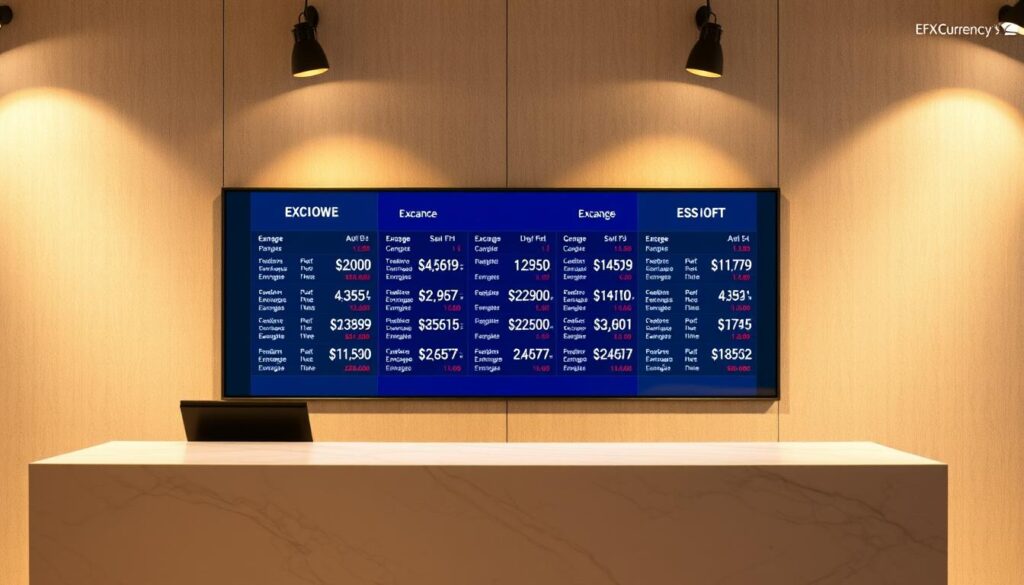The global financial landscape thrives on continuous exchange between nations. At its core lies the world’s largest marketplace, operating 24 hours daily across five business days. This decentralized network facilitates over $6.6 trillion in daily transactions – equivalent to $250 billion hourly.
Price relationships between national monetary systems form the foundation of this ecosystem. These combinations serve as the primary tools for speculating on economic shifts. Retail traders, institutions, and multinational corporations all participate in this dynamic environment.
Nearly 90% of activity involves predicting future valuation changes rather than physical currency conversion. This speculative focus creates opportunities for strategic positioning. Mastering these instruments requires understanding their structure and interaction patterns.
Effective navigation begins with recognizing how different economies influence each other through exchange rates. Successful participants analyze geopolitical events, interest rates, and trade balances to anticipate movements. This knowledge transforms random bets into calculated decisions.
London remains a pivotal hub in this round-the-clock operation, reflecting the UK’s significant role in global finance. Whether managing risk or seeking profit, grasping these fundamentals proves essential for consistent results in international markets.
Introduction to the Forex Market and Currency Pair Mechanics
Every transaction in international markets hinges on a fundamental exchange principle. Participants always deal with two monetary units simultaneously when executing trades. This structure ensures each purchase automatically involves selling another asset.
The base currency acts as the primary unit in these combinations, appearing first in their designation. Its counterpart, the quote currency, shows how much it costs to acquire one base unit. For instance, GBP/USD priced at 1.3800 means £1 equals $1.38.
Market data reflects this relationship through dynamic pricing. Traders analyze these values to predict shifts between national economies. Proper interpretation helps calculate potential gains or losses before entering positions.
Three critical elements define this system:
- Simultaneous buying and selling in every trade
- Clear hierarchy between base and quoted units
- Real-time pricing reflecting global economic health
Mastering these mechanics transforms raw data into actionable insights. It lays the groundwork for advanced strategies involving market trends and economic indicators.
Understanding Major Currency Pairs and Their Global Impact
EUR/USD’s 22.7% market share in 2022 reveals its unmatched dominance among monetary combinations. According to Bank for International Settlements data, this single currency pair handles nearly a quarter of daily transactions. Together, major currency pairs drive 75% of all activity, forming the backbone of international exchange markets.
Four traditional giants anchor this group: EUR/USD, USD/JPY, GBP/USD, and USD/CHF. These combinations directly link to the world’s largest economies. Many analysts also include AUD/USD, USD/CAD, and NZD/USD – often called ‘commodity duos’ due to their ties to natural resources.
Three key advantages make these instruments preferred choices:
- High liquidity enabling swift trade execution
- Tighter spreads reducing transaction costs
- Predictable patterns from abundant market data
The EUR/USD relationship particularly mirrors transatlantic economic health. Shifts in this currency pair often signal changing trade balances between Europe and North America. Traders monitor these movements to gauge broader market sentiment.
Understanding major currency pairs helps identify cost-effective opportunities. Their liquidity ensures minimal price manipulation, while historical trends provide reliable analysis frameworks. These factors make them essential tools for navigating global markets.
Exploring Minor and Exotic Forex Pairs

Beyond the well-trodden paths of major exchanges lie opportunities in less familiar territories. Minor and exotic combinations offer distinct advantages and challenges for traders seeking diversification. These instruments often reveal hidden correlations between global economies.
Defining Minor Versus Exotic Pairs
Minor combinations exclude the US dollar, linking two major economies instead. Examples like EUR/CHF or GBP/AUD reflect European and Commonwealth market interactions. These instruments typically show moderate liquidity compared to their dollar-based counterparts.
Exotic pairs involve one major and one emerging economy currency. USD/TRY (US dollar vs Turkish lira) exemplifies this category. Trading volumes here remain sparse, often leading to unpredictable price jumps during news events.
Market Liquidity and Volatility Considerations
Three critical factors differentiate these instruments:
- Spread widths exceeding 20 pips during off-peak hours
- Price gaps caused by political announcements or commodity shifts
- Limited technical analysis support due to scarce historical patterns
South African rand or Mexican peso combinations demonstrate typical exotic behavior. Sudden 3% daily swings occur twice as frequently compared to major counterparts. Risk management becomes paramount when navigating these waters.
Seasoned traders often allocate less than 5% of their portfolio to such instruments. While potential rewards exist, the required vigilance and capital reserves make them unsuitable for beginners. Proper research mitigates but never eliminates inherent uncertainties.
The Influence of Interest Rates on Currency Movements

Central banks wield significant power over exchange valuations through rate adjustments. When the European Central Bank raises borrowing costs while the Federal Reserve holds steady, EUR/USD often climbs as investors chase better returns. This dynamic creates predictable patterns across global markets.
Higher interest rates act like magnets for international capital. Investors naturally gravitate toward assets offering stronger yields, boosting demand for the associated monetary unit. This principle explains why currency pairs like GBP/USD surge when the Bank of England outpaces other central banks.
Three critical factors drive these movements:
- Rate differentials between nations
- Economic growth projections
- Central bank policy statements
Traders scrutinize inflation reports and employment data to predict rate changes. The Fed’s 2022 aggressive hikes, for instance, propelled the dollar against most forex pairs. Savvy market participants position themselves weeks before major announcements.
Understanding these mechanics transforms rate decisions from random events into strategic opportunities. Those who track policy shifts gain an edge in timing entries and exits across volatile markets.
forex currency pairs: Their Role in Trading Strategies

Market participants constantly navigate a dual-price reality when executing transactions. Every instrument displays two values: the bid (selling price) and ask (buying price). This dual quotation system determines immediate trading costs and potential profitability.
Interpreting Bid, Ask, and Spread Dynamics
The gap between bid and ask prices – known as the spread – acts as a transaction fee. Major combinations often show spreads under 2 pips during active trading hours. Exotic instruments might exhibit gaps exceeding 50 pips, significantly impacting profit margins.
Three factors influence spread behavior:
- Market liquidity levels
- Economic event volatility
- Trading session overlaps
Brokers play a critical role in pricing transparency. Some platforms offer fixed spreads, while others use variable models that widen during news releases. Savvy traders compare these structures before committing capital.
Understanding these mechanics helps optimize entry points. Tight spreads on liquid instruments allow quicker position adjustments. This knowledge becomes vital when managing multiple trades or using short-term strategies.
Economic Events and Central Bank Policies

Global markets react instantly to policy shifts and economic reports, creating rapid valuation changes across international exchanges. Central bank decisions can alter market trajectories within milliseconds, demanding constant vigilance from participants.
How Policy Announcements Affect Trading
When the Federal Reserve hints at interest rates adjustments, related instruments often swing 1-3% within minutes. The European Central Bank’s 2022 emergency meeting caused EUR/USD to plummet 140 pips in 15 seconds. Three elements amplify these reactions:
- Unexpected policy changes versus market expectations
- Forward guidance about future economic plans
- Coordinated actions between multiple central banks
Impact of Global Economic Indicators
Critical reports like US non-farm payrolls or German inflation data serve as market catalysts. Traders analyze these releases to predict currency pair movements:
- GDP growth rates indicating economic health
- Consumer price indexes shaping interest rates decisions
- Trade balance figures revealing export competitiveness
Smart participants use economic calendars to prepare for volatility spikes. During major announcements, liquidity often evaporates before rebounding with renewed momentum. This pattern creates both risks and opportunities for strategic positioning.
Liquidity, Spreads, and Trading Volume: What Traders Need to Know

Market liquidity determines how easily positions can enter or exit without price disruption. Instruments like EUR/USD handle billions daily, creating razor-thin spreads under 1 pip. This efficiency attracts both institutional and retail participants seeking cost-effective trades.
High liquidity acts as a safety net during volatile periods. Major combinations trade round-the-clock, ensuring consistent pricing across time zones. Overlapping sessions between London and New York often see spreads tighten further, offering prime execution windows.
Three factors shape trading costs:
- Transaction volume influencing spread width
- Broker pricing models during news events
- Regional market hours affecting order flow
Less popular instruments present high risk scenarios. Exotic combinations may widen spreads to 20+ pips, increasing the chance of losing money through slippage. Even minor news can trigger erratic price jumps in these thinly traded markets.
Smart traders match their strategy to liquidity profiles. Large accounts favor liquid currency pairs for minimal market impact. Smaller portfolios might explore niche opportunities but require tighter stop-losses to manage high risk exposure.
Understanding these dynamics helps prevent losing money on unexpected costs. Always assess spread behavior and volume trends before committing capital to any currency pair.
Analyzing Currency Correlations in the Forex Market

Market dynamics often reveal hidden connections between seemingly unrelated assets. These relationships, measured through correlation coefficients, show how instruments move in tandem or opposition. Savvy traders use this data to avoid overlapping risks and identify strategic opportunities.
Understanding Positive and Negative Correlations
Positive correlations occur when two instruments rise or fall together. For example, EUR/USD and GBP/USD often move similarly due to shared exposure to dollar strength. Conversely, negative correlations appear when one rises as the other falls – like USD/CHF and gold prices during market uncertainty.
The EUR/JPY combination demonstrates how cross-pairs derive value from underlying relationships. Its fluctuations often mirror combined movements of EUR/USD and USD/JPY. Three factors drive these connections:
- Shared economic exposures between regions
- Commodity price influences on specific currencies
- Interest rate differentials shaping capital flows
Correlation coefficients range from -1 (perfect opposites) to +1 (identical movements). These values shift with economic conditions – a pairing showing 0.8 correlation today might drop to 0.3 during geopolitical crises. Regular monitoring helps adjust strategies before positions become overexposed.
Effective traders use these patterns to balance portfolios and hedge risks. When historical correlations break temporarily, sharp-eyed participants spot arbitrage windows. This approach transforms abstract data into actionable market intelligence.
Technical Analysis: Chart Patterns and Historical Trends
Chart patterns act as historical footprints in financial markets, revealing repeated investor behaviors. These formations help traders anticipate potential price movements by identifying support levels and resistance zones. Real-time rate updates from global banks create microsecond advantages for those interpreting data swiftly.
Key Indicators and Price Movements
Moving averages smooth out market noise, highlighting directional trends across currency pairs. The Relative Strength Index (RSI) flags overbought or oversold conditions, often preceding reversals. Candlestick patterns like dojis or engulfing bars signal shifts in buyer-seller balance.
Utilizing Trend Analysis in Trading
Trendlines connecting peaks or troughs establish actionable boundaries for entries and exits. Breakouts above consolidation zones frequently trigger accelerated price movements. Historical data scarcity in niche instruments demands adaptive strategies – combining technical signals with real-time liquidity checks.
Successful traders layer multiple indicators to confirm signals. A 50-day average crossing above 200-day often attracts momentum buyers in major forex pairs. Always cross-verify patterns with volume data to avoid false breakouts during low-activity sessions.



